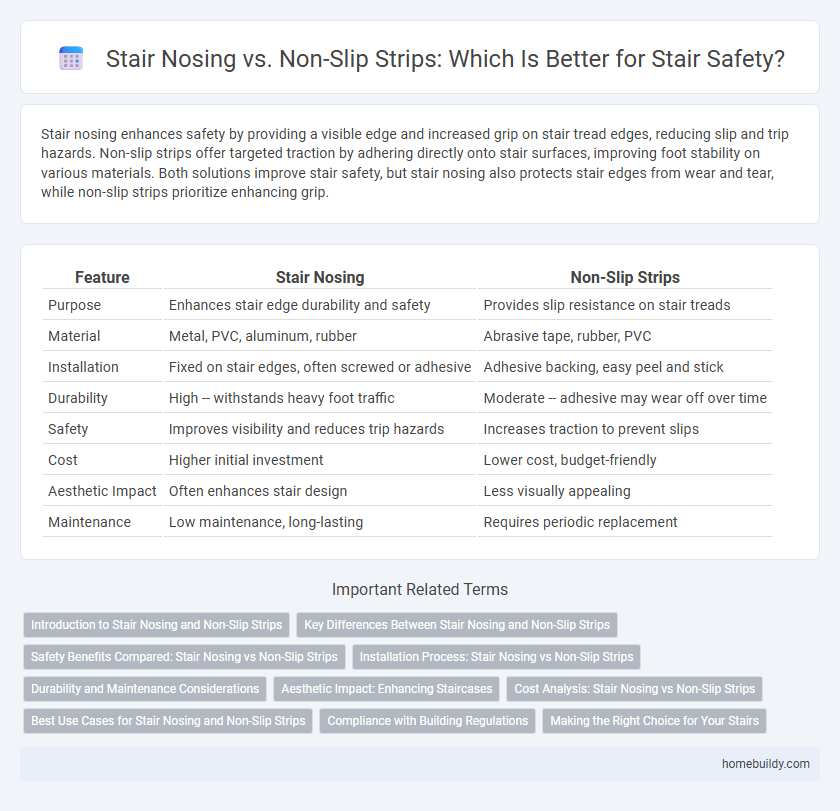Stair nosing enhances safety by providing a visible edge and increased grip on stair tread edges, reducing slip and trip hazards. Non-slip strips offer targeted traction by adhering directly onto stair surfaces, improving foot stability on various materials. Both solutions improve stair safety, but stair nosing also protects stair edges from wear and tear, while non-slip strips prioritize enhancing grip.
Table of Comparison
| Feature | Stair Nosing | Non-Slip Strips |
|---|---|---|
| Purpose | Enhances stair edge durability and safety | Provides slip resistance on stair treads |
| Material | Metal, PVC, aluminum, rubber | Abrasive tape, rubber, PVC |
| Installation | Fixed on stair edges, often screwed or adhesive | Adhesive backing, easy peel and stick |
| Durability | High -- withstands heavy foot traffic | Moderate -- adhesive may wear off over time |
| Safety | Improves visibility and reduces trip hazards | Increases traction to prevent slips |
| Cost | Higher initial investment | Lower cost, budget-friendly |
| Aesthetic Impact | Often enhances stair design | Less visually appealing |
| Maintenance | Low maintenance, long-lasting | Requires periodic replacement |
Introduction to Stair Nosing and Non-Slip Strips
Stair nosing enhances stair safety by providing a durable edge that improves traction and visibility, reducing slip and trip hazards. Non-slip strips are adhesive or mechanical treads applied to stair surfaces to increase grip but often lack the structural reinforcement stair nosing provides. Compared to non-slip strips, stair nosing offers greater durability, edge protection, and compliance with building safety codes, making it a preferred choice in high-traffic or commercial staircases.
Key Differences Between Stair Nosing and Non-Slip Strips
Stair nosing provides a durable edge protection that enhances stair safety by increasing visibility and reducing wear on stair edges, while non-slip strips primarily focus on improving traction to prevent slips and falls. Stair nosing is typically made from metal, rubber, or PVC and is designed to fit over the stair tread edge for long-lasting durability, whereas non-slip strips are adhesive tapes or tapes with abrasive surfaces applied directly to the stair tread surface. Installation complexity and lifespan differ as well; stair nosing requires more effort to install but lasts longer and offers better structural support compared to frequently replaced non-slip strips.
Safety Benefits Compared: Stair Nosing vs Non-Slip Strips
Stair nosing enhances safety by providing a visible edge and increased traction, reducing the risk of slips and falls more effectively than non-slip strips. Unlike non-slip strips, stair nosing is a durable, integrated solution that protects the stair edge from wear while improving grip. Its design improves foot placement awareness, making it a superior choice for high-traffic areas requiring enhanced safety measures.
Installation Process: Stair Nosing vs Non-Slip Strips
Stair nosing installation involves securely anchoring durable materials such as aluminum or PVC to stair edges, often requiring drilling and precise measurements to fit each step. Non-slip strips are typically adhesive-backed and apply directly to the stair surface, making installation faster and less labor-intensive but generally less durable. Proper installation of stair nosing ensures long-term safety and wear resistance, while non-slip strips provide a quick, temporary solution for improving traction.
Durability and Maintenance Considerations
Stair nosing offers superior durability compared to non-slip strips due to its robust materials such as aluminum or vinyl, which withstand heavy foot traffic and environmental wear. Maintenance of stair nosing is minimal, requiring only occasional cleaning to remove dirt and debris, whereas non-slip strips often need frequent replacement or reapplication as adhesive weakens and the surface wears down. Choosing stair nosing enhances long-term safety and cost-efficiency by reducing the need for frequent repairs and replacements.
Aesthetic Impact: Enhancing Staircases
Stair nosing provides a seamless and polished finish that enhances the overall aesthetics of staircases by blending with the design and material of the stairs. Non-slip strips, while functional, often appear as separate elements that can disrupt the visual flow and detract from the elegance of the staircase. Choosing stair nosing not only improves safety but also maintains and enhances the staircase's aesthetic appeal through integrated design.
Cost Analysis: Stair Nosing vs Non-Slip Strips
Stair nosing typically involves higher upfront costs due to durable materials like aluminum or rubber and professional installation, providing long-term durability and compliance with safety codes. Non-slip strips are more affordable initially, with easy DIY application, but may require frequent replacements, increasing maintenance expenses over time. Evaluating the total cost of ownership, stair nosing often proves more cost-effective in commercial and high-traffic settings due to enhanced lifespan and safety benefits.
Best Use Cases for Stair Nosing and Non-Slip Strips
Stair nosing is best used for protecting stair edges from wear and enhancing safety in high-traffic areas, offering improved durability and visibility compared to non-slip strips. Non-slip strips are ideal for temporary or budget-friendly solutions, providing effective slip resistance on smooth or polished surfaces without altering stair structure. For long-term safety and structural reinforcement, stair nosing provides superior impact resistance and complies with building codes more effectively than non-slip strips.
Compliance with Building Regulations
Stair nosing is designed to meet specific building regulations by enhancing safety, durability, and visibility on stair edges, often adhering to standards such as the ADA and UK Building Regulations. Non-slip strips may provide surface traction but typically lack the structural reinforcement and consistent compliance certification required by official safety codes. Choosing stair nosing ensures compliance with regulatory requirements for slip resistance, edge protection, and fire safety in commercial and residential buildings.
Making the Right Choice for Your Stairs
Stair nosing provides enhanced durability and integrates seamlessly with stair design, offering superior protection against edge wear compared to non-slip strips. Non-slip strips primarily focus on traction but may wear out quickly and require frequent replacement, making stair nosing a cost-effective long-term solution. Choosing stair nosing ensures compliance with safety standards while improving aesthetic appeal and structural integrity.
Stair nosing vs non-slip strips Infographic

 homebuildy.com
homebuildy.com